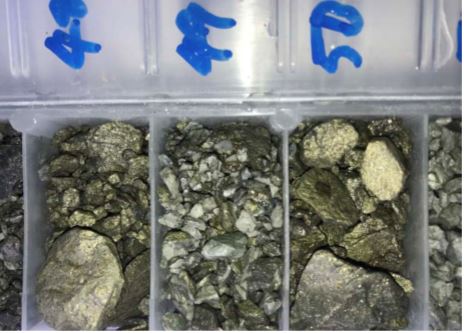Castillo uncovers shallow copper and zinc at its Cangai mine
Mining
Mining
Special report: Castillo Copper has hit massive sulphides with visible copper and zinc close to surface in its second drilling program at the Cangai mine in New South Wales.
“This is an excellent start to our second drilling campaign,” chairman Peter Meagher said.
“Hitting highly mineralised semi-massive and massive sulphides in multiple holes from 41m near the start of the drilling program is truly a game-changer, especially with 34 more drill-holes to complete.
“This early result materially de-risks the project and firmly places our core strategic objective to re-open the Cangai copper mine on track.”
The standout result was an intersection of 10m massive sulphides from 41m and 2m massive sulphides from 56m.
The goal of the phase two drilling program is to grow the current resource of 35 million tonnes at 3.35 per cent copper – which is already one of Australia’s highest grade JORC-compliant inferred resources for copper.
JORC refers to the mining industry’s official code for reporting exploration results, mineral resources and ore reserves, managed by the Australasian Joint Ore Reserves Committee.
Mineral resources are categorised in order of increasing geological confidence as inferred, indicated or measured.

Exploration upside
So far, with only five drill-holes completed out of a 39-hole drilling campaign, there is arguably significant incremental exploration upside and potential to expand the resource size as the program progresses.
Castillo believes the newly found semi-massive and massive sulphides validate that there may be significant incremental mineralisation to be discovered as the drilling campaign progresses.
This has prompted the company to accelerate its exploration effort.
It is now refining the drill program to identify extensions to the mineralisation and is mobilising a diamond drill rig to site to undertake follow-up infill work.
Castillo has already proven it can get high copper recoveries and grades from the stockpiles at the Cangai mine.
Testing on samples taking from the two “McDonough’s” stockpiles earlier in August confirmed recoveries of over 80 per cent with grades of up to 22 per cent copper and 300 parts per million (ppm) cobalt.
Grades of between 0.5 per cent and 1.5 per cent are considered good and anything above that is considered high-grade.
Castillo is optimistic that further testwork on samples from the McDonough’s stockpile may produce improved recoveries and higher grades.
The company is fast tracking metallurgical test work and the modelling of the resource for the stockpiles after receiving strong interest from customers interested in buying the discarded ore.
This special report is brought to you by Castillo Copper.
This advice has been prepared without taking into account your objectives, financial situation or needs. You should, therefore, consider the appropriateness of the advice, in light of your own objectives, financial situation or needs, before acting on the advice.
If this advice relates to the acquisition, or possible acquisition, of a particular financial product, the recipient should obtain a disclosure document, a Product Disclosure Statement or an offer document (PDS) relating to the product and consider the PDS before making any decision about whether to acquire the product.